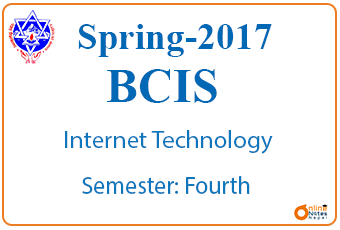Published by: sadikshya
Published date: 25 Jun 2021

This is the question set along with answers of Internet Technology Spring 2017, which was taken by the Pokhara University.
Pokhara University – Internet Technology, Spring 2017
| Level: Bachelor | Semester – Spring | Year: 2017 |
| Program: BCIS | Full Marks: 100 | |
| Course: Internet Technology (Web Programming)
|
Pass Marks: 45 | |
| Time: 3hrs. | ||
|
Section “A” Very Short Answer Questions Attempt all the questions. |
10×2 |
|
| 1. | Can a web page contain multiple
elements? |
|
| 2. | What is Digital Signature? | |
| 3. | Explain MIME on the web. | |
| 4. | Explain local Storage and session Storage? | |
| 5. | What is XML? | |
| 6. | What is the purpose of HTTPS? | |
| 7. | Can acontain
elements and vice-versa? |
|
| 8. | What is difference between include_once() and include ()? | |
| 9. | What are CSS media queries and what are they used for? | |
| 10. | What are “web workers”? | |
|
Section “B” Descriptive Answer Questions Attempt any six questions |
6×10 | |
| 11. | Differentiate between User-centric and Data-centric tier. Explain the 3 – Tier technology with reference to web hosting. | |
| 12. | a) Define browser compatibility. Create a basic structure of HTML5.
b) What are parts of DHTML? Differentiate between client-side and server-side programming. |
|
| 13. | Write down the basic HTML code for the following table to display on a browser.
|
|
| 14. | a) What is DOM? Explain types of a dialog box used in JavaScript.
b) What are the categories of VPN? How do SSL works? |
|
| 15. | How copyright differ from Intellectual Property rights (IPRs)? What are the terms of Protection on works offered by the Copyright Act, 2002? | |
| 16. | a) What is the frame? Explain the advantage and disadvantages of the frame.
b) What are things to be considered while designing a web page? List them briefly. |
|
| 17. | What is CMS? What are the advantages and disadvantages of using open CMS? | |
| 18. | How can we apply the CSS to an HTML document explain with examples? | |
|
19.
|
Section “C”
Case Analysis Yolo IT Solutions approaches to develop web-based applications where users are allowed to login only after the registration process completes. The task is as follows: a) Register if the user is not registered which consists of the following fields: Full Name, Email, Picture, Phone, Gender, Username, Password, Country, and Hobbies. b) Create the user login module and check appropriate validation also redirect the user to the homepage upon proper authorization. (Assume remote server: “http://172.1.2.3:1521/emp_yolo” also assume your own database and table name). |